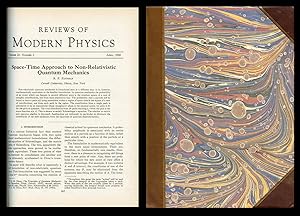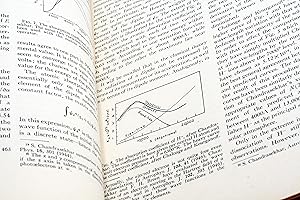Space Time Approach Non Relativistic Quantum Mechanics by Feynman Richard (2 results)
FeedbackSearch filters
Product Type
- All Product Types
- Books (2)
- Magazines & Periodicals (No further results match this refinement)
- Comics (No further results match this refinement)
- Sheet Music (No further results match this refinement)
- Art, Prints & Posters (No further results match this refinement)
- Photographs (No further results match this refinement)
- Maps (No further results match this refinement)
- Manuscripts & Paper Collectibles (No further results match this refinement)
Condition
- All Conditions
- New (No further results match this refinement)
- Used (2)
Binding
- All Bindings
- Hardcover (No further results match this refinement)
- Softcover (1)
Collectible Attributes
- First Edition (2)
- Signed (No further results match this refinement)
- Dust Jacket (No further results match this refinement)
- Seller-Supplied Images (2)
- Not Print on Demand (2)
Free Shipping
- Free Shipping to U.S.A. (No further results match this refinement)
Seller Rating
-
Space-Time Approach to Non-Relativistic Quantum Mechanics in Reviews of Modern Physics, Vol. 20, pp. 367 to 387, 1948
Published by American Physical Society, Lancaster, PA, 1948
Seller: Atticus Rare Books, West Branch, IA, U.S.A.
First Edition
1st Edition. FIRST EDITION, FULL VOLUME in PRISTINE CONDITION, OF FEYNMAN'S NOBEL PRIZE WINNING PATH-INTEGRAL FORMALISM, A "REFORMATION OF QUANTUM MECHANICS ITSELF" (American National Biography). Feynman's path-integral formulation of quantum mechanics lead physicists out of the morass of endless calculations and provided them with the simplest, most elegant, most powerful - to say nothing of the most revolutionary - method for solving the fundamental equations of quantum mechanics. Feynman's "path-integral formulation of quantum mechanics is a description of quantum theory that generalizes the action principle of classical mechanics. It replaces the classical notion of a single, unique trajectory for a quantum particle or system" with the idea that the evolution of a quantum system is determined as a sum over - or integration of -- all the possible trajectories that would take that system from the initial to the final state of its dynamical evolution (Wenner Collection). While Feynman's approach, as ever, was intuitive, his idea of summing over all paths has been characterized simply as "everything that can happen does happen." Richard Feynman "had unusual mathematical skill, but his greatest virtues as a physicist were his physical intuition and his delight in finding simple and elegant approaches to problems that had baffled everyone else" (Peacock, The Quantum Revolution, 102). There are three pivotal formulations of quantum mechanics: Heisenberg's matrix formulation, Schrödinger's wave equation formulation, and Feynman's path-integral formulation. Feynman began work on his path-integral formulation because, as he often said, "he could not understand standard quantum theory and had to recreate it on his own" (ibid). Feynman introduced his path-integral method in the paper offered here, describing it as a "space-time approach to non-relativistic quantum mechanics" that was meant to provide an alternative to the "very well-established formulation of quantum mechanical time-evolution based on the Schrodinger and the Heisenberg pictures of quantum mechanics" (Prugovecki, Principles of Quantum), 88). "Ultimately what distinguished Feynman's approach from the standard formalism lay not in outcomes, but in. his "conceptual approach. Heisenberg and Bohr had argued vehemently during the 1920s that quantum mechanics spelled the end for any type of visualization of the atomic domain" (DSB, XXI, 21). Feynman response was the path-integral formulation, "an intuitive approach built around picturing the paths of particles through space and time" (ibid). His formulation represented a different way of thinking "that is probably as visualizable as any theory of quantum fields is ever going to be" - and in part because it could be delineated, could be diagrammed, it has spurred the study of and illuminated some of the deepest aspects of quantum mechanics" (Peacock). Later in life and while speaking of both that with his path-integral formulation, quantum theory was simpler than classical theory, as well as of those "deepest aspects of quantum mechanics," Feynman "who understood quantum theory as well as anyone, said, "I still get nervous with it.I cannot define the real problem, therefore I suspect there's no real problem, but I'm not sure there's no real problem. The problem is not with using the theory â?? making calculations, applying it to engineering tasks â?? but in understanding what it means. What does it tell us about the world?" (Gleick, What is Real? ). In 1965, Feynman (with Tomonaga and Schwinger) won the 1965 Nobel Prize for "fundamental work in quantum electrodynamics, with deep-ploughing consequences for the physics of elementary particles" (Nobel Foundation). CONDITION: Lancaster, PA, American Physical Society, 1948. 4to. Handsome complete volume. Rebound in ¾ gilt-tooled brown cloth over marbled boards. Black cloth, gilt-lettered labels. Not a library book; clean & bright with no markings whatsoever inside & out. Near fine condition.
-
Space-Time Approach to Non-Relativistic Quantum Mechanics
Published by American Physical Society, Lancaster, PA, 1948
Seller: Manhattan Rare Book Company, ABAA, ILAB, New York, NY, U.S.A.
First Edition
Original wrappers. Condition: Very Good. First edition. First edition, first printing, of Feynman's path integral formalism, his revolutionary approach to solving the fundamental equations of quantum mechanics and the basis for his later famous formulations of "Feynman rules" and "Feynman diagrams". "In mid-1947 friends of Feynman persuaded him - threats and cajoling were required - to write for publication the theoretical ideas they kept hearing him explain. When he finally did, he used no diagrams. The result was partly a reworking of his thesis, but it also showed the maturing and broadening of his command of the issues of quantum electrodynamics. He expressed the tenets of his new vision with unabashed plainness. For some physicists this would be the most influential set of ideas Feynman ever published. "He said he had developed an alternative formulation of quantum mechanics to add to the pair of formulations produced two decades before by Schrodinger and Heisenberg. He defined the notion of probability amplitude for a space-time path. In the classical world one could merely add probabilities. in the quantum world probabilities were expressed as complex numbers, numbers with both a quantity and a phase, and these so-called amplitudes were squared to produce a probability. This was the mathematical procedure necessary to capture the wavelike aspects of particle behavior. "Probability amplitudes were normally associated with the likelihood of a particle's arriving at a certain place at a certain time. Feynman said he would associate the probability amplitude 'with an entire motion of a particle'- with a path. He stated the central principle of his quantum mechanics: The probability of an event which can happen in several different ways is the absolute square of a sum of complex contributions, one from each alternative way. These complex numbers, these amplitudes, were written in terms of the classical action; he showed how to calculate the action for each path as a certain integral. And he established that this peculiar approach was mathematically equivalent to the standard Schrodinger wave function, so different in spirit. "The Physical Review had printed nothing by Feynman since his undergraduate thesis almost a decade before. To his dismay, the editors now rejected this paper. Bethe helped him rewrite it, showing him how to spell out for the reader what was old and what was new, and he tried the more retrospective journal Reviews of Modern Physics, where finally it appeared the next spring under the title 'Space-Time Approach to Non-Relativistic Quantum Mechanics'." (Gleick). FEYNMAN, RICHARD. "Space-Time Approach to Non-Relativistic Quantum Mechanics". In: Reviews of Modern Physics, vol. 20, no. 2 (April 1948): 367-87. Lancaster, PA: American Physical Society, 1948. First edition, first printing. Quarto, original printed wrappers. With neat ownership signature on front wrapper ("H.T. Epstein") of distinguished physicist and biophysicist Herman T. Epstein (1920-2007). Very mild, general wear; a near-fine copy, rare in original wrappers and without any institutional stamps. Note: A custom cloth box can be made for this item for an additional $250. References: Gleick, James, Genius: The Life and Science of Richard Feynman (New York: Pantheon Books, 1992), p. 247-49). "Invention of the path integral formalism for quantum mechanics". Ezhela, V.V., Particle Physics: One Hundred Years of Discoveries, An Annotated Chronological Bibliography (Woodbury, NY: American Institute of Physics Press, 1996).



